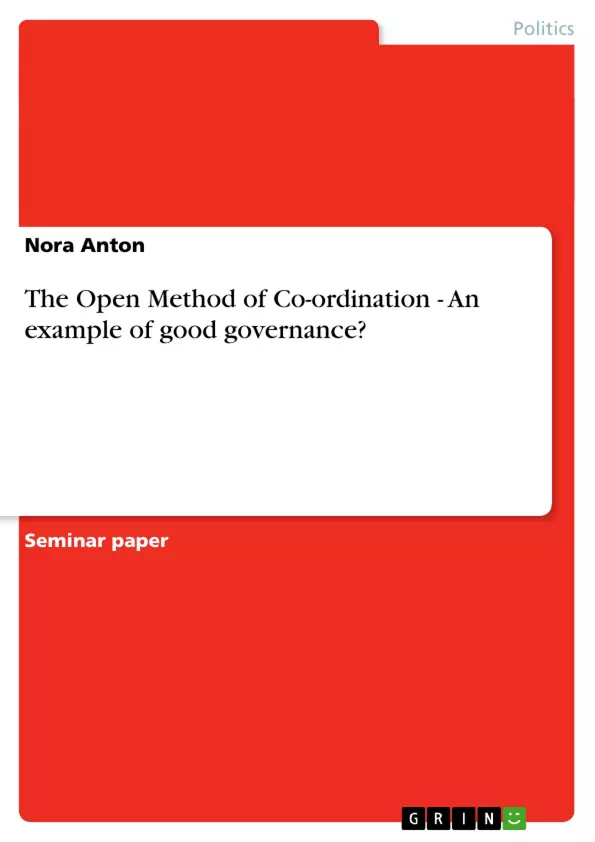Growing European economic, social and cultural integration has implied an ever rising and ever more direct impact of the European Union on various aspects of the lives of its citizens. Although it remains uncontested that integration has brought a long period of stability and economic growth to the region, questions have increasingly been raised about the democratic legitimacy of the EU rule. After all, members of the most important Community Institutions are not democratically elected for the tasks they carry out and methods of policy-making are often too complicated for being traced by the public.
There is one policy area which has a very direct effect on citizens’ lives and which is more and more concerned by integration: social policy. This is why it is preferred to other areas which would of course also have been suitable to serve as a concrete example in this investigation. In consideration of the facts that the settings of European welfare states are too diverse to find a one-fits-all solution, and that national leaders have been reluctant to cede this policy area to the supranational level, a new method has progressively been applied to the different fields of social policy: the Open Method of Co-ordination (OMC), a very prominent example of multi-level and multi-actor governance. At first, guidelines - which are not legally binding - are passed by the Council. Their implementation is then completely left to the member states. Important features of this method include the identification of best practices in member states, benchmarking and peer review.
In 2000, the Commission, aware of a growing distrust of the citizens towards the EU, decided to initiate a governance reform, setting out five principles of good governance to be observed in EU policy making: transparency, participation, accountability, effectiveness and coherence.
This paper will outline the processes of OMC and, referring to different stages of the policy chain, examine the question to what extent the OMC as applied in social policies meets these criteria at this stage and where there is still a need for improvement.
Inhaltsverzeichnis (Table of Contents)
- INTRODUCTION
- THE COMMISSION WHITE PAPER ON GOOD GOVERNANCE
- THE OPEN METHOD OF CO-ORDINATION
- HISTORY
- PROCEDURE
- ASSESSING THE OPEN METHOD OF CO-ORDINATION UNDER THE CRITERIA OF GOOD GOVERNANCE
- TRANSPARENCY
- PARTICIPATION
- Direct Participation in the EES and Inclusion OMCS
- Participation in the Pensions OMC
- Some General Concerns about Participation in the OMC
- EFFECTIVENESS
- ACCOUNTABILITY AND RESPONSIBILITY
- COHERENCE
- CONCLUSION
Zielsetzung und Themenschwerpunkte (Objectives and Key Themes)
This research paper examines the Open Method of Co-ordination (OMC) within the context of social policy in the European Union, assessing its alignment with the Commission’s five principles of good governance: transparency, participation, accountability, effectiveness, and coherence. The paper aims to determine whether the OMC, as applied in social policies, meets these criteria and where improvements are needed.
- Democratic legitimacy of the EU in relation to social policy
- The Open Method of Co-ordination (OMC) as a multi-level governance approach
- Good governance principles and their application to the OMC
- Assessment of OMC’s performance in relation to transparency, participation, accountability, effectiveness, and coherence
- Potential areas for improvement in the OMC process
Zusammenfassung der Kapitel (Chapter Summaries)
- Introduction: The paper sets the context by highlighting the growing impact of the EU on citizens' lives, particularly in the area of social policy. It introduces the Open Method of Co-ordination (OMC) as a key example of multi-level governance in this domain, emphasizing its reliance on non-binding guidelines, best practice identification, benchmarking, and peer review.
- The Commission White Paper on Good Governance: This chapter explores the theoretical approaches to addressing the democratic legitimacy of the EU, outlining the views of intergovernmentalists and federalists. It then discusses practical efforts to enhance legitimacy, including treaty streamlining, European Parliament empowerment, and the creation of common European symbols. The Commission White Paper on European Governance is introduced, outlining its five principles of good governance: transparency, participation, accountability, effectiveness, and coherence.
- The Open Method of Co-ordination: This chapter delves into the history and functioning of the Open Method of Co-ordination (OMC), outlining its evolution as a policy-making tool in social policy areas. It explores the specific procedures involved, highlighting the role of non-binding guidelines, member state implementation, and the importance of best practice identification and peer review.
Schlüsselwörter (Keywords)
The key concepts and terms explored in this paper include: European Union, social policy, Open Method of Co-ordination (OMC), good governance, transparency, participation, accountability, effectiveness, coherence, multi-level governance, multi-actor governance, democratic legitimacy, European Commission, European Parliament, member states, best practices, benchmarking, peer review.
- Citar trabajo
- Nora Anton (Autor), 2006, The Open Method of Co-ordination - An example of good governance?, Múnich, GRIN Verlag, https://www.grin.com/document/85364



